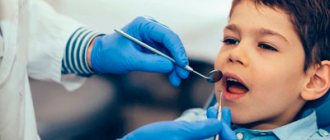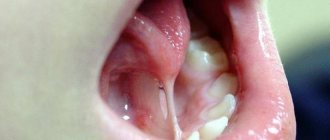The time when a child is cutting his adult teeth is one of the most serious and difficult periods of his development. To help the baby survive it without problems, parents need to know what symptoms indicate the eruption of molars, and how to help the child in this situation.
Teething of molars in children: symptoms
Molar milk teeth
What do parents need to know about baby teeth?
- Deciduous incisors, like permanent incisors, have a root.
- The rudiments of such dental units are formed in the prenatal period.
- When a temporary tooth is replaced by an adult one, the old root eventually resolves on its own.
- On the first teeth the enamel is softer.
- Baby teeth are smooth and have wide roots to provide room for the development of permanent tooth buds.
- Temporary teeth are canines and lateral incisors, central and first molars, premolars. The second molars in four-year-old children are already adults.
Baby teeth
When the rudiments of an adult tooth appear, the root of its predecessor weakens and the tooth becomes loose. If it is not pulled out, an adult tooth may be visible underneath it. When milk interferes with it, it can grow with deviations from the norm.
The dentition is symmetrical in nature, and teeth erupt in pairs: on both parts of the dentition they appear almost simultaneously.
The structure of baby teeth
Video: Eruption of molars in children - important nuances
How does the growth process of molars occur?
At 12-13 years of age, a child, as a rule, no longer has milk teeth, although their roots dissolve earlier. At this point, there are part of the molars in the mouth with fully and partially formed roots.
Dental roots go through 2 stages in their development:
- the period of unformed apex (the root is still as long as possible, the walls are parallel, the canal is wide);
- the stage of an unclosed apex (the formation of the apex ends, the walls of the canal come closer together).
The roots of the lower jaw form faster than the upper jaw. This process also has approximate deadlines, but they can shift in both directions. Therefore, it is definitely impossible to answer the question at what age children develop permanent teeth - canines, incisors or molars. As with dairy products, everything is individual here.
Timing of adult teeth eruption
The rudiments of the first teeth (on average, about 20 units) in infants are formed during the first two years of life. When the time comes to replace them with permanent teeth, the milk teeth become loose and fall out. There are no specific dates for the eruption of molars; many factors can affect the speed: environmental conditions, climate, water quality and diet. Genetic characteristics also play a certain role, some of which make themselves felt even during the formation of the fetus. The influence can be both positive and negative. If parents have healthy teeth from birth, then you don’t have to worry about the child’s teeth. If the first incisors, canines and premolars grow in 3 years, then the permanent ones take a long time to erupt. The first symptoms of dentition change can be seen at the age of 5, and it continues until the age of 21, when the third molars appear.
Video: Timing of eruption of permanent teeth
Timing of eruption
How long do permanent teeth grow?
There are no exact dates for the growth of permanent teeth; in each case, individual characteristics of the body and hereditary factors play a role.
Time frame for the final formation of the root system of molars:
- incisors located in the center - climb by 10 years;
- lateral incisors - by 10 years;
- fangs - by the age of 13;
- first premolars - emerge by age 12;
- second premolars – 1 to 12 years;
- first molars – by 10 years;
- second molars are cut by the age of 15.
The rate of tooth growth is different for each group. Rapid eruption is observed in the second premolars; in six months they rise by 8 mm. The incisors located in the center rise by 12 mm per year, and the canines grow to 13 mm in two years.
If there is a slight increase over a long period of time, you should see a doctor. Perhaps the child has problems related to the replacement of milk units.
Signs of formation of permanent teeth
The most characteristic symptom of the formation of adult teeth in childhood is the growth of jaw size. The gaps between the first teeth are small; if the jaw grows, this means that it creates conditions for new dental units. Adult teeth are larger than temporary teeth, so they require a lot of space. The distance between baby teeth increases. They lose stability and fall out. With any deviations, the teeth will break through with pain, bend, and ruin the bite. In order for a child’s teeth to grow correctly, parents need to control this process.
Pay attention to the distance between your child's teeth
Permanent teeth can erupt at 6-7 years of age without any symptoms, but most often the child behaves restlessly, is capricious, gets irritated over trifles, and eats poorly. Often the formation of permanent teeth has the same signs as during the eruption of milk teeth. If other diseases occur during teething, they can distort the symptoms.
- How to make teething easier for babies
Permanent teeth erupt at 6 or 7 years of age
Increased secretion of saliva is a very common symptom, although it is no longer as abundant as in infancy, but the difference can be noticed. At the age of 6, children can already be taught to wipe their mouth with a napkin, otherwise irritation will appear on the face, since saliva contains many microbes that aggressively affect delicate skin.
If your child is drooling, have a supply of clean tissues ready.
During the period of growth of permanent teeth, the gums and mucous membranes become inflamed again. If you notice redness in the mouth, it is better to show the child to a dentist, who can accurately distinguish the beginning of teething from a banal viral infection.
Take your child to the dentist if you notice redness in your child's mouth
Over time, swelling is observed on the gums - this is an adult tooth making its way to replace the temporary one. The germination process is painful; parents can alleviate the child’s condition with anesthetics.
Pain is replaced by itching. The child pulls any things to his mouth to soothe his gums.
The child may suck or chew fingers or other objects
A natural symptom will be deterioration in sleep quality. If he is bothered by toothache, the baby will not be able to fall asleep for a long time, often wakes up at night, cries, and tosses and turns.
If your baby is having difficulty sleeping and crying, this could be a symptom of teething.
Some children develop a fever, cough, and upset stool.
Fever and cough may appear
The listed signs may appear periodically and do not necessarily have to be present in all children.
Sequence of eruption of permanent teeth
Milk teeth have a weak root system, which begins to dissolve by the age of 7. Therefore, in addition to changing incisors and molars, a new bite is formed. Sequence of physiological process:
- from 6-7 years old the first molars appear;
- then, by the age of 7-8 years , the incisors located in the center are replaced;
- by the age of 8-9 years, the lateral primary incisors are renewed with permanent units;
- at 10-12 years of age the relay moves to the first premolars;
- permanent clicks replace milk predecessors closer to 9-11 years ;
- from 10-12 years of age, the second premolars erupt;
- by the age of 13, the second molars are formed;
- Third molars appear between the ages of 16 and 25 ; in some people they never appear.
Names of teeth for easy reference in tables.
The order of appearance of adult teeth
Almost all milk teeth that erupted in the first two and a half years, 10 on each half, are replaced by permanent ones. Compared to their predecessors, adult teeth form in a different order.
Table. The order of formation of permanent teeth
| Tooth name | Development timeframe | Peculiarities |
| Lower and then upper molars | This usually occurs in the seventh year of life | They make their way behind the second primary molars |
| Molar lateral | This can take three years – from 6 to 9 years old | They sprout when the central incisors are already formed |
| Permanent fangs | Normally, this occurs between the ages of 9 and 11 years. | By cutting the gum from the inside, they seem to displace milk precursors |
| First and second adult premolars | Appears at 10-13 years of age | They grow in place of central incisors, which become loose and fall out. |
| Third molars, better known as wisdom teeth | They may erupt at 18 years old, or at 25, or not at all. | Such cases are not considered a deviation from the norm. |
If a baby's individual teeth grow in a different order, this is not dangerous. Individual characteristics, deficiency of vitamins and minerals slow down the speed and sequence of formation of permanent teeth. It is important for parents to know that an adult tooth should not become loose; if there are similar symptoms, this should be a reason to visit the dentist.
- Teething in children: sequence up to one year
Teeth may fall out and grow in random order in different children
Permanent teeth should not be loose
What permanent teeth should children have at different ages?
On average, the timing of eruption does not vary much. In hotter climates this process occurs faster:
- Central incisors - make themselves felt in the period from 5-7 to 6-9 years.
- Lateral - a little later, from 7 to 10-11 years.
- Fangs - on average appear at 12-13 years of age (some experts expand this range to 9-14).
- First premolars - can appear between the ages of 9 and 12-13 years.
- Second premolars – opinions differ regarding these teeth: 9-11, 9-15, 10-14 years.
- First molars are among the earliest: from 5 to 8 years.
- Second molars - in the period from 10 to 15 years, but more often at 12-13 years.
- Third molars - after 18 years (according to various sources, up to 20-25 years).
Researchers give different timing of eruption, since they rely on results from different regions, with different climates, which greatly influences the replacement process.
Associated symptoms
These symptoms do not appear very often, but they cannot be ignored. If the baby has a fever, an incomprehensible cough, or diarrhea, this can be either a sign of infection or a reaction of a weakened body to pathogenic microflora.
Diarrhea can be a sign not only of teething, but also of various diseases
When teeth are forming, the temperature usually lasts for 3-4 days at 38.5°C. This symptom is irregular, so fever in children should be periodic. If it persists for a long time, you need to show the child to the pediatrician. Some doctors believe that cold symptoms have nothing to do with teething and prescribe appropriate treatment for cough and fever.
If the temperature lasts longer than three days, you should consult a doctor.
Adults also don’t understand what cough and runny nose have to do with new teeth. The gums are directly connected to the blood supply to the nose and respiratory tract. As teeth form, blood flow increases in the mouth. The nasal mucosa is close, so its glands also begin to produce more mucus, which children try to get rid of. Remaining mucus settles into the throat, irritating the airways and causing a cough.
A runny nose may occur when teething
Another symptom is loose stools with a frequency of no more than 3 times a day. While scratching his gums, the baby constantly puts dirty fingers and the first objects he comes across into his mouth. In addition to infection, diarrhea is facilitated by increased salivation, which constantly flushes the intestines. If the stool is short-lived and does not contain blood, there is no need to worry about the child’s health. It is necessary to monitor his condition, since with a weakened immune system there is always a risk of developing an infection, which aggravates all the symptoms.
When is there a reason to visit the dentist?
The formation of the dentition requires constant monitoring and competent assistance from the parents to the child, so that in case of developmental deviations, pathology is noticed in time.
- Teething in children: how to relieve pain
It is good if, when the first permanent teeth appear, the child visits the pediatric dentist for preventive purposes.
Such an examination will help identify a number of problems:
- malocclusion;
- gum disease;
- inadequate mineralization of enamel;
- curvature of the dentition;
- milk caries.
Malocclusion
Caries of baby teeth
Insufficient attention to teeth in childhood means not only excruciating pain, tears and insomnia for the whole family, but also painful treatment and fear of the dentist for life. Therefore, it is important to constantly maintain contact with your doctor and devote enough time to the health of your children.
Losing the first teeth is a natural process for all children. And you only need to worry when problems arise with the formation of adult teeth. They can be prevented if the eruption of the first tooth is controlled. Jaw hurts after tooth extraction, you will find the answer in the link.











